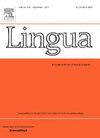南非英语中的重复:“什么”的借用有了自己的生命
IF 1.3
3区 文学
0 LANGUAGE & LINGUISTICS
引用次数: 0
摘要
南非英语(SAfE)中重复的现象比其他英语变体更为普遍,但在研究中却没有引起太多关注。本文研究了重复what的用法。在考虑外语中重复语的使用以及其他语言在当地语言生态中可能产生的影响之前,对全球英语重复语的范围进行了调查。然后,对两个语料库进行语料库分析,分别代表电视肥皂剧(2006-2023)和NOW语料库(2010-2023)的用户评论。结果表明,what-what传达的意思是“等等”(“还有更多这样的东西”),Whatever(没有阐明的模糊事物的一般指示),以及一个特定的事物或品质(故意没有命名)。虽然许多重复形式可以与其他南非语言中的先行词联系起来,但结果表明,自从在SAfE中使用以来,what已经获得了新的含义,这创造性地扩展了该结构的潜力,而不仅仅是从其他语言迁移过来的。重复不仅是外汇局词汇创造的一种根深蒂固的语法结构,而且也成为外汇局用户表达本地身份的一种方式。本文章由计算机程序翻译,如有差异,请以英文原文为准。
Reduplication in South African Englishes: A what-what borrowing gets a life of its own
Reduplication is more common in South African English (SAfE) than in many other varieties of English but has not received much attention in research. This article examines the use of the reduplication what-what. The scope of reduplication in English globally is surveyed before considering the use of reduplication in SAfE alongside possible influences of other languages in the local linguistic ecology. Thereafter, a corpus analysis is undertaken of two corpora, representing user comments on television soap operas (2006–2023) and news and comments from the NOW corpus (2010–2023). The results indicate that what-what conveys the meanings of Etcetera (‘there is more like this’), Whatever (a general indicator of something vague that is not spelled out), and a Specific thing or quality (which is deliberately not named). While many reduplication forms can be linked to antecedents in other South African languages, the results show that what-what has acquired new meanings since coming into use in SAfE, which creatively extend the potential of the construction beyond mere transfer from other languages. Reduplication is not only an entrenched grammatical construction for coining new words in SAfE, but it has also become a way to express local identity for users of SAfE.
求助全文
通过发布文献求助,成功后即可免费获取论文全文。
去求助
来源期刊

Lingua
Multiple-
CiteScore
2.50
自引率
9.10%
发文量
93
审稿时长
24 weeks
期刊介绍:
Lingua publishes papers of any length, if justified, as well as review articles surveying developments in the various fields of linguistics, and occasional discussions. A considerable number of pages in each issue are devoted to critical book reviews. Lingua also publishes Lingua Franca articles consisting of provocative exchanges expressing strong opinions on central topics in linguistics; The Decade In articles which are educational articles offering the nonspecialist linguist an overview of a given area of study; and Taking up the Gauntlet special issues composed of a set number of papers examining one set of data and exploring whose theory offers the most insight with a minimal set of assumptions and a maximum of arguments.
 求助内容:
求助内容: 应助结果提醒方式:
应助结果提醒方式:


